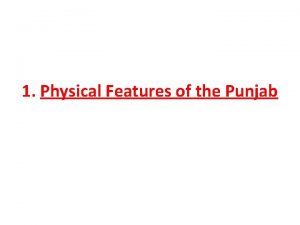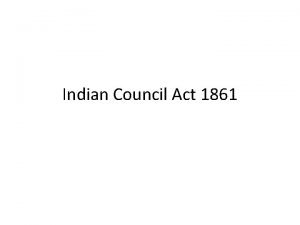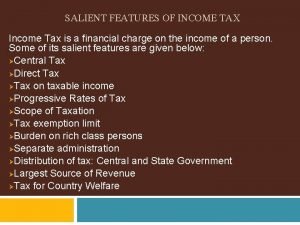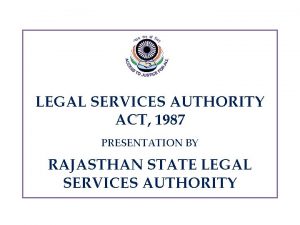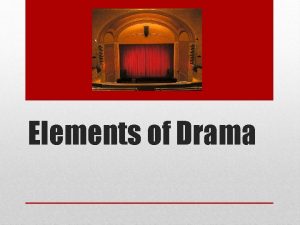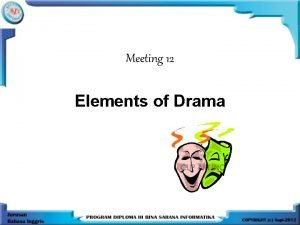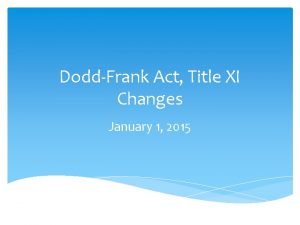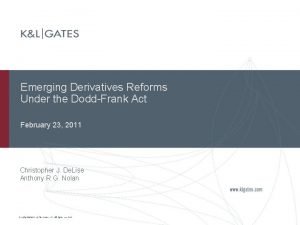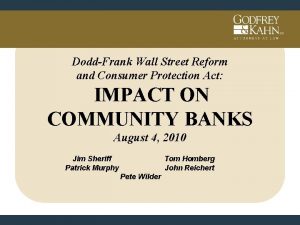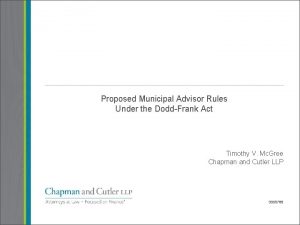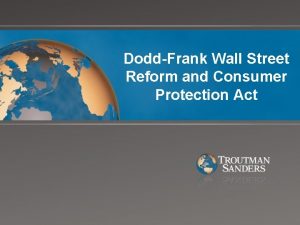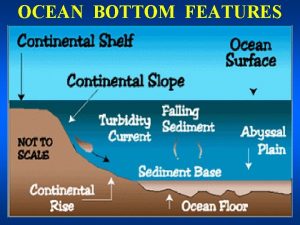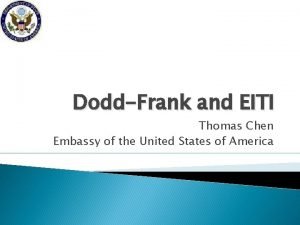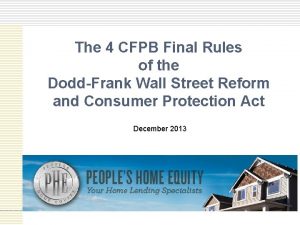DoddFrank Act What Are Its Key Features How






















- Slides: 22

Dodd-Frank Act: What Are Its Key Features, How Much Progress Has Been Made on Implementation, and Will It Improve the Financial System James R. Barth (Auburn University and Milken Institute), Penny Prabha (Milken Institute) Clas Wihlborg (Chapman University) The 89 th Western Economic Association Annual Conference June 27 - July 1, 2014 Grand Hyatt Denver, Colorado

Outline 1. Introduction • Dodd-Frank’s main goal: to strengthen and expand the scope of regulatory powers so that regulators are better able to intervene in a timelier manner when troublesome situations arise. 2. Historical Perspective on Dodd-Frank 3. Key Features and Implementation Progress of Dodd-Frank 4. An Assessment of Dodd-Frank

An Historical Perspective on the Dodd-Frank Act Timeline of major banking laws Source: Milken Institute.

New financial regulatory structure Source: Milken Institute.

Key Features and Implementation Progress • • • Regulatory Capital Standards Consumer Protections Financial Stability Oversight Council A New Resolution Process Prohibition of Propriety Trading Derivative Instruments Shareholders and Executive Compensation Credit Rating Agencies Securitization Federal Reserve Emergency Lending Authority

Implementation Progress: Percentage of Rulemakings Finalized Note: There are the 398 Total Required Rulemakings. The information are as of June 2014. Source: Dodd-Frank Progress Reports, Davis Polk

Implementation Progress: Select Categories Note: There are the 398 Total Required Rulemakings. The information are as of June 2014. Source: Dodd-Frank Progress Reports, Davis Polk

Assessment • Assessment based on the following factors: Will Dodd-Frank reduce the likelihood of “regulatory failure”? Will Dodd-Frank increase or reduce “regulatory burden”? Will Dodd-Frank increase market discipline? Will Dodd-Frank contribute to efficiency and stability in the financial system? • No actions taken with respect to Fannie Mae and Freddie Mac

1. Regulatory Capital Standards Goal Assessment To ensure a safer and sounder banking system • Important feature – likely to address a FI’s contribution to systemic risk • Emphasis on risk-based capital requirements vs. a simple leverage requirement • Risk-taking behavior associated with a bank’s business model (such as wholesale funding) Key Features • Minimum leverage and risk-based capital requirements • Stress testing conducted on large FIs (a bank with assets > $50 b) • Maximum 15 -to-1 leverage ratio • “Prompt corrective action”

Capital ratios in the quarter prior to first receiving bailout funds (in most cases, the data are as of Q 3 2008). Sources: Bloomberg, Milken Institute.

2. Consumer Protections Goal Protect consumers from abusive practices by FI’s. Key Features • Creates a Bureau of Consumer Financial Protection • Imposes minimum standards for residential mortgage loans • Allow states to impose stricter consumer laws on national banks • Deposit insurance raised to $250, 000 Assessment • Important feature – likely to reduce the likelihood of regulatory failures • Does the success of the Bureau mean an increase in the regulatory burden for banks? • Expansion of DI may decrease effective market discipline and may lead to greater systemic instability.

3. Financial Stability Oversight Council Goal Assessment Identify risks to U. S. financial stability and address them through appropriate regulatory agencies • Important feature – likely to reduce the likelihood of regulatory failure • Political factors – will appropriate action be taken against insolvencies? Key Features • Designates SIFIs and assesses risks posed by them (banks and non-banks) • Standardization of risk measurement – a proper way to evaluate risk? • Establishes the Office of Financial Research to support the duties of FSOC • • Recommends prudential capital standards Does reference to “systemically important” FIs imply that these FIs are TBTF (and would be bailed out if they face financial difficult)?

Combined assets of the 50 biggest bank holding companies Sources: The Banker, Federal Reserve, the U. S. Bureau of Economic Analysis, and Milken Institute.

4. A New Resolution Process (Orderly Liquidation Authority) Goal Mitigate moral hazard and systemic risk Key Features • Orderly Liquidation Authority – to liquidate failing BHCs • FDIC as a receiver and runs liquidation process Assessment • Important feature – likely to increase market discipline • Its effectiveness depends on the credibility of no bailout policy.

BHCs with assets > $50 billion Bank Total Assets (12/31/2013) Participated in the 2014 Dodd-Frank Act stress test G-SIBs identified by FSB 1 JPMorgan Chase & Co. $2, 416 2 Bank Of America Corporation $2, 105 3 Citigroup Inc. $1, 880 4 Wells Fargo & Company $1, 527 5 Goldman Sachs Group, Inc. $912 6 Morgan Stanley $833 7 American International Group, Inc. $541 8 General Electric Capital Corporation $524 9 Bank of New York Mellon Corporation $374 10 U. S. Bancorp $364 11 PNC Financial Services Group, Inc. $321 12 Capital One Financial Corporation $297 13 HSBC North America Holdings Inc. $290 14 Teachers Insurance & Annuity Association of America $250 15 State Street Corporation $243 16 TD Bank US Holding Company $235 17 BB&T Corporation $183 18 Sun. Trust Banks, Inc. $175 19 American Express Company $153 20 Ally Financial Inc. $151

BHCs with assets > $50 billion (cont. ) Bank Total Assets (12/31/2013) Participated in the 2014 Dodd-Frank Act stress test 21 Charles Schwab Corporation $144 22 Fifth Third Bancorp $130 23 State Farm Mutual Automobile Insurance $129 24 United Services Automobile Association $122 25 RBS Citizens Financial Group, Inc. $122 26 Regions Financial Corporation $118 27 BMO Financial Corp. $111 28 Union. Ban. Cal Corporation $106 29 Northern Trust Corporation $103 30 Key. Corp $93 31 M&T Bank Corporation $85 32 Banc. West Corporation $84 33 Discover Financial Services $79 34 Santander Holdings USA, Inc. $77 35 BBVA Compass Bancshares, Inc. $72 36 Deutsche Bank Trust Corporation $67 37 Comerica Incorporated $65 38 Huntington Bancshares Incorporated $59 39 Zions Bancorporation $56 G-SIBs identified by FSB

5. Prohibition of Propriety Trading (Volcker Rule) Goal Assessment To separate financial intermediation functions from the presumed more speculative business • Modest contribution to financial stability Key Features • Difficult to implement • • Not allow proprietary trading • No strong evidence that propriety trading caused the crisis (no banks’ ownership of hedge funds) • Requires that the implicit protection on non-traditional banking activities must Restrict bank ownership in hedge funds be credibly removed. and private equity funds

6. Derivative Instruments Goal To increase transparency and reduce counterparty risk of OTC derivatives Key Features • Mandatory clearing • Mandatory trade execution • Minimum capital and margin requirements for swap dealers and major swap participants • Derivatives for hedging purposes exempted Assessment • Important feature – likely to increase financial stability, but the net impact is unclear. • Centralized trading platforms or poorly managed clearinghouses may increase systemic risks.

7. Shareholders and Executive Compensation Goal Assessment To place limits on the level and form of executive pay in the banking sector • Modest contribution to financial stability Key Features • Provides shareholders with a nonbinding vote on executive pay • Gives SEC authority to grant shareholders the ability to nominate their own directors • Reduces risk-taking decisions on the part of managers, but limits on pay may compromise the ability of financial firms to attract the best talent.

8. Credit Rating Agencies Goal Assessment To reduce regulatory reliance on credit rating agencies (and therefore to reduce a • The net impact is unclear bias towards high credit ratings) • This regulation makes the rating agencies more careful in their assessments. Key Features • Establishes the Office of Credit Ratings within the SEC • Empowers the SEC to deregister a CRA that fails to provide accurate ratings • Allows investors to sue CRAs • Disclosure requirements • Burdens may fall on small credit rating agencies (and make the 3 major CRAs more important).

9. Securitization Goal Assessment To increase banks’ incentive to screen and monitor the loans (if they were required to hold a portion of the securitized loans) • Important feature – likely to increase financial stability Key Features • Requires banks that packaged loans to keep 5% of credit risk on their balance sheet • Low-risk residential mortgages exempted • Unintended consequence? Given that securitization helps increase lending capacity of FIs and therefore economic performance

10. Federal Reserve Emergency Lending Authority Goal Assessment To protect taxpayers from losses when the • Important feature – likely to reduce the Fed provides financial assistance to a FI likelihood of regulatory failures Key Features • Establishes policies and procedures to ensure that the lending program is to provide liquidity, and not to bail an insolvent FI • Increases Fed transparency • Waiting for an approval by the Secretary of Treasury to supply liquidity can be costly at the time of financial distress. • Full disclosure requirements may discourage weak banks from obtaining liquidity assistance.
 Mikael ferm
Mikael ferm Act 1 act 2 act 3
Act 1 act 2 act 3 Canvas key partners
Canvas key partners Key partners key activities key resources
Key partners key activities key resources Physical features of punjab and its ancient history
Physical features of punjab and its ancient history The emigree poem analysis
The emigree poem analysis When a train increases its velocity its momentum
When a train increases its velocity its momentum Sunny rainy snowy windy cloudy
Sunny rainy snowy windy cloudy If its square its a sonnet
If its square its a sonnet Its halloween its halloween the moon is full and bright
Its halloween its halloween the moon is full and bright Its not easy but its worth it
Its not easy but its worth it Salient features of ndps act 1985
Salient features of ndps act 1985 Indian councils act 1861
Indian councils act 1861 Salient features of income tax
Salient features of income tax Salient features of rte act 2009
Salient features of rte act 2009 Rajasthan legal services authority
Rajasthan legal services authority Features of fema
Features of fema Trichinella spiralis morphology
Trichinella spiralis morphology C-its delegated act
C-its delegated act South asia physical features
South asia physical features Key features of drama
Key features of drama Key features and benefits
Key features and benefits Basic elements of drama
Basic elements of drama




